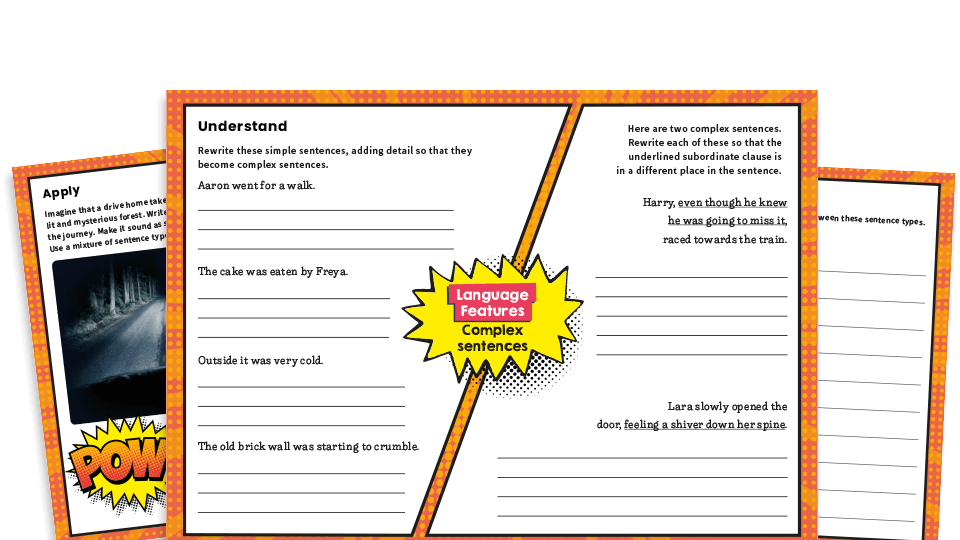Complex Sentences KS2 – Examples and Worksheet

Resource Collection
Effective Writing

Subscribe today and receive…
- Unlimited access to 1000s of resources
- 80+ CPD guides and 60+ training videos
- Access to THREE whole-school curriculums:
- Real Writing
- Real Comprehension
- Real Grammar - The complete Word Whosh vocabulary building programme
- Free subscription to Teach Reading & Writing magazine, and digital access to all back issues
- Exclusive, member-only resource collections
- New resources added every week
This worksheet is an excellent way for Key Stage 2 pupils to revise and practise recognising and using complex sentences in KS2. It contains examples of subordinating conjunctions and complex sentences with five different challenges, which can be tackled during one lesson or spread over a number of teaching sessions.
Questions encourage creative responses as well as an opportunity for revision, and include interesting images to stimulate ideas.
- Understand
Rewrite the simple sentences, adding detail so that they become complex sentences. Rewrite the sentences so that the underlined subordinate clause is in a different place.
- Challenge
Look at the picture and write three complex sentences based on it.
- Test
Choose whether the examples are complex sentences or compound sentences. Circle the independent clause and underline the subordinate clause in the example sentences.
- Explain
Write an explanation of the difference between simple, compound and complex sentences. Write an example for each one.
- Apply
Imagine that a drive home takes you through a dimly lit and mysterious forest. Write a short passage about the journey. Make it sound as spooky as possible. Use a mixture of sentence types to increase tension.
This 15-minute challenge features activities that include SATs-style questions and opportunities for creative writing responses, with eye-catching images as prompts.
What is a complex sentence?
A complex sentence consists of a main clause (a simple sentence) and one or more dependent clauses. Dependent clauses can be created via subordinating conjunctions or by using relative clauses to add extra information.
Classifying sentences as ‘simple’ or ‘complex’ can be confusing, because a ‘simple’ sentence may be complicated, and a ‘complex’ one may be straightforward. The terms ‘single-clause sentence’ and ‘multi-clause sentence’ may be more helpful.
Complex sentences KS2 examples
- Harry, even though he knew he was going to miss it, raced towards the train.
- Lara slowly opened the door, feeling a shiver down her spine.
- She went shopping but took back everything she had bought because she didn’t like any of it.
National Curriculum English programme of study links
Pupils should be taught to:
(Year 3) Extend the range of sentences with more than one clause by using a wider range of conjunctions, including when, if, because, although
(Year 5) Use relative clauses beginning with who, which, where, when, whose, that or with an implied (i.e. omitted) relative pronoun.

This resource is part of the Effective Writing collection.
View more from this collection
- worksheet
Look inside!
Click through to see what this resource has to offer
More from this collection
Browse by Year Group
Year
1
Year
2
Year
3
Year
4
Year
5
Year
6
Upgrade now
Click 'Upgrade now' to activate your subscription. An invoice will appear on your accounts page and be sent by email. Once paid, the benefits of your full account will be unlocked within five days.











